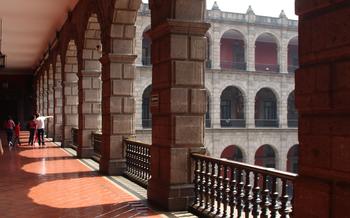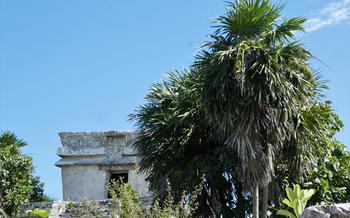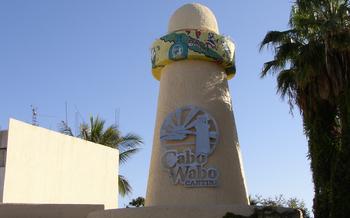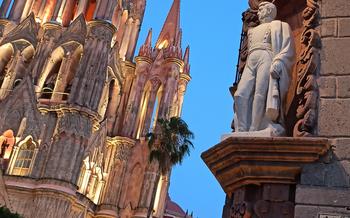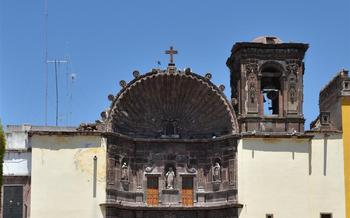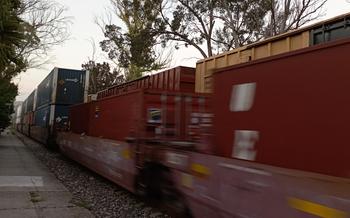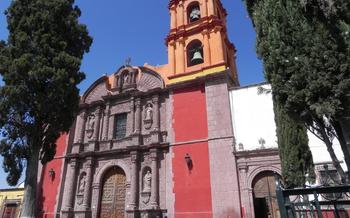
Torture Museum (Museo de la Tortura)
- A Journey Through Torment: Unveiling the Museo de la Tortura
- Step into the Shadows: Exploring the Museum's Exhibits
- The Faces of Suffering: Remembering the Victims
- The Resilience of the Human Spirit: Stories of Survival
- The Fight for Human Rights: Combating Torture Worldwide
- The Challenges of Rehabilitation: Healing the Wounds of Torture
- Artistic Representations: Torture in Literature, Film, and Art
- Mexico's Struggle for Justice: Addressing Past Wrongs
- Insider Tip: Plan Your Visit Carefully
A Journey Through Torment: Unveiling the Museo de la Tortura
stands as a testament to the dark and often forgotten history of human suffering. Established in 2007, the museum's mission is to preserve the memory of Mexico's past, a period marked by widespread torture and abuse. Through its collection of artifacts, multimedia presentations, and personal accounts, the museum offers a chilling glimpse into the depths of human cruelty and the resilience of the human spirit.
Location and Accessibility: The Museo de la Tortura is conveniently located in the heart of Guanajuato's historic center, a UNESCO World Heritage Site. Situated on the bustling Calle Positos, the museum is easily accessible on foot or by public transportation.
Admission and Hours of Operation: The museum is open to the public from Tuesday to Sunday, with varied hours of operation depending on the season. Admission fees are relatively affordable, with discounts available for students and seniors.
Ethical Considerations: Visiting a museum dedicated to torture raises important ethical considerations. It is crucial to approach the exhibits with respect and empathy, remembering that the instruments on display were once used to inflict unimaginable pain and suffering on real individuals.
Step into the Shadows: Exploring the Museum's Exhibits
The Museo de la Tortura is a journey through the dark recesses of human history, where suffering and cruelty have left their mark. The museum is divided into thematic zones, each focusing on a different aspect of torture. From the Middle Ages, where instruments of pain were crude and brutal, to the modern era, where technology has refined the art of inflicting agony, the museum's exhibits offer a comprehensive perspective on the history of torture.
One of the most striking aspects of the museum is its collection of torture devices. From the iron maiden, a spiked coffin that crushed its victims, to the rack, which stretched their bodies to the breaking point, these instruments are a chilling reminder of the horrors people have inflicted on one another. Alongside these physical artifacts, the museum also features multimedia presentations that bring the stories of torture victims to life. Visitors can watch videos of survivors sharing their experiences, listen to audio recordings of interrogations, and read letters written by prisoners. The emotional impact of these exhibits is profound, leaving visitors with a deep sense of empathy and revulsion.
The Faces of Suffering: Remembering the Victims
The Museo de la Tortura not only showcases instruments of pain but also honors the memory of those who endured unimaginable suffering. Through personal accounts and stories, visitors gain insight into the lives of real individuals who fell victim to torture. These stories shed light on the human cost of cruelty and the resilience of the human spirit in the face of adversity. By remembering the victims, the museum serves as a powerful reminder of the importance of fighting against torture and promoting human rights. Furthermore, the exhibits explore the symbolism behind the artifacts and their representation of power, cruelty, and resilience. This analysis helps visitors understand the deeper meanings and implications of the instruments on display.
The Resilience of the Human Spirit: Stories of Survival
Amidst the horrors depicted within the Museo de la Tortura, there shines a beacon of hope in the stories of those who endured and survived unimaginable suffering. These individuals, hailing from diverse backgrounds and experiences, embody the indomitable spirit of the human will.
Their tales of resilience, courage, and determination serve as a powerful testament to the capacity for survival even in the face of unspeakable cruelty. They recount the harrowing ordeals they faced, the depths of despair they plunged into, and the unwavering resolve that ultimately carried them through.
The power of hope, like a flickering flame in the darkest of nights, sustained these individuals during their darkest hours. They clung to the belief that their ordeal would end, that justice would prevail, and that they would emerge from their torment transformed.
The support of fellow prisoners, family members, and human rights organizations played a crucial role in their survival. These networks of solidarity provided emotional succor, practical assistance, and a glimmer of humanity amidst the dehumanizing conditions they endured.
Once liberated from their torment, these survivors carried the scars of their experiences, both physical and psychological. Yet, they refused to be defined by their suffering. Instead, they chose to channel their pain into a force for good, becoming advocates for justice, human rights, and the prevention of torture.
Their tireless efforts to raise awareness, educate the public, and push for legal and policy changes have made a profound impact in the fight against torture. Their voices, amplified by their lived experiences, resonate with a power that cannot be ignored.
The stories of torture survivors are a stark reminder of the resilience of the human spirit, the capacity for hope in the face of adversity, and the importance of solidarity in the pursuit of justice. They inspire us to stand in solidarity with those who continue to endure torture, to advocate for their rights, and to work tirelessly to create a world where such atrocities are consigned to the history books.
The Fight for Human Rights: Combating Torture Worldwide
International Conventions: The international community has made significant strides in condemning and prohibiting torture through various conventions and treaties. The most notable among these is the United Nations Convention against Torture, adopted in 1984 and ratified by over 150 countries. This treaty defines torture as any act by which severe pain or suffering, whether physical or mental, is intentionally inflicted on a person for such purposes as obtaining information or a confession, punishing him or a third person, or intimidating or coercing him or a third person. The convention explicitly prohibits torture in all circumstances, without any exceptions, and requires states to take effective measures to prevent and punish acts of torture.
The Role of Human Rights Organizations: Human rights organizations play a crucial role in documenting, exposing, and advocating against torture worldwide. These organizations, such as Amnesty International and Human Rights Watch, conduct investigations, gather evidence, and publish reports that shed light on the prevalence of torture and the conditions in which it is practiced. They also advocate for the rights of torture survivors, providing legal and psychological support, and campaigning for justice and accountability.
Grassroots Movements: In addition to international conventions and human rights organizations, grassroots movements and initiatives are also working tirelessly to end torture around the world. These movements often focus on specific countries or regions where torture is prevalent, raising awareness, mobilizing public support, and advocating for legislative changes and policy reforms. They also provide direct assistance to torture survivors, offering counseling, medical care, and legal representation.
The Power of Public Awareness: Raising public awareness about torture is crucial in building support for its eradication. When people are informed about the horrors of torture and its devastating consequences, they are more likely to demand action from their governments and support organizations working to combat it. Public awareness campaigns, media coverage, and educational programs play a vital role in shedding light on this hidden issue and mobilizing public opinion against torture.
The Challenges of Rehabilitation: Healing the Wounds of Torture
Torture leaves profound scars, both physical and psychological. Survivors often grapple with chronic pain, post-traumatic stress disorder (PTSD), depression, and other health issues. The rehabilitation of torture survivors requires specialized care and support to address their unique needs.
Providing comprehensive care for torture survivors is challenging due to the complex and often severe nature of their injuries. Specialized healthcare, psychological counseling, and social support are crucial for their recovery and reintegration into society. Access to education, employment, and healthcare is essential to help survivors rebuild their lives and regain a sense of purpose.
Community support plays a vital role in the rehabilitation process. By creating a supportive and understanding environment, communities can help survivors feel safe, valued, and connected. This can facilitate their healing and empower them to move forward with their lives.
Artistic Representations: Torture in Literature, Film, and Art
Torture has been a recurring theme in literature, film, and art throughout history, serving as a powerful tool to raise awareness, provoke thought, and challenge societal norms. Literary works such as "1984" by George Orwell and "The Gulag Archipelago" by Aleksandr Solzhenitsyn offer harrowing accounts of torture and its dehumanizing effects. In film, movies like "The Passion of the Christ" by Mel Gibson and "Zero Dark Thirty" by Kathryn Bigelow have sparked controversy and debate by depicting graphic scenes of torture. Visual art has also played a significant role in representing torture, with works like Francisco Goya's "The Third of May 1808" and Pablo Picasso's "Guernica" serving as powerful indictments against the horrors of war and state-sanctioned violence. These artistic representations not only provide a window into the experiences of torture victims but also challenge viewers to confront the ethical dilemmas and human rights implications of this abhorrent practice.
Mexico's Struggle for Justice: Addressing Past Wrongs
Mexico has embarked on a complex journey towards confronting its history of torture and seeking justice for victims. Truth and reconciliation commissions have played a crucial role in this process, aiming to shed light on past atrocities and promote healing within society. Apologies and reparations for victims have been recognized as essential steps in acknowledging the suffering endured and facilitating the path towards recovery. However, the challenge of impunity remains significant, as many perpetrators of torture have yet to be held accountable for their actions. Mexico's efforts to address its troubled past continue, with a focus on promoting healing, reconciliation, and ensuring that the voices of victims are heard and their rights are upheld.
Insider Tip: Plan Your Visit Carefully
To make the most of your visit to the Museo de la Tortura, consider booking a guided tour. These tours are led by knowledgeable guides who can provide deeper insights into the exhibits and their historical context. It's essential to be prepared for the museum's disturbing and emotionally challenging content. Be mindful and respectful of the solemn nature of the museum, avoiding inappropriate behavior or taking photos of the exhibits. Allow ample time to explore the museum and absorb the information presented. This will ensure a meaningful and thought-provoking experience.
